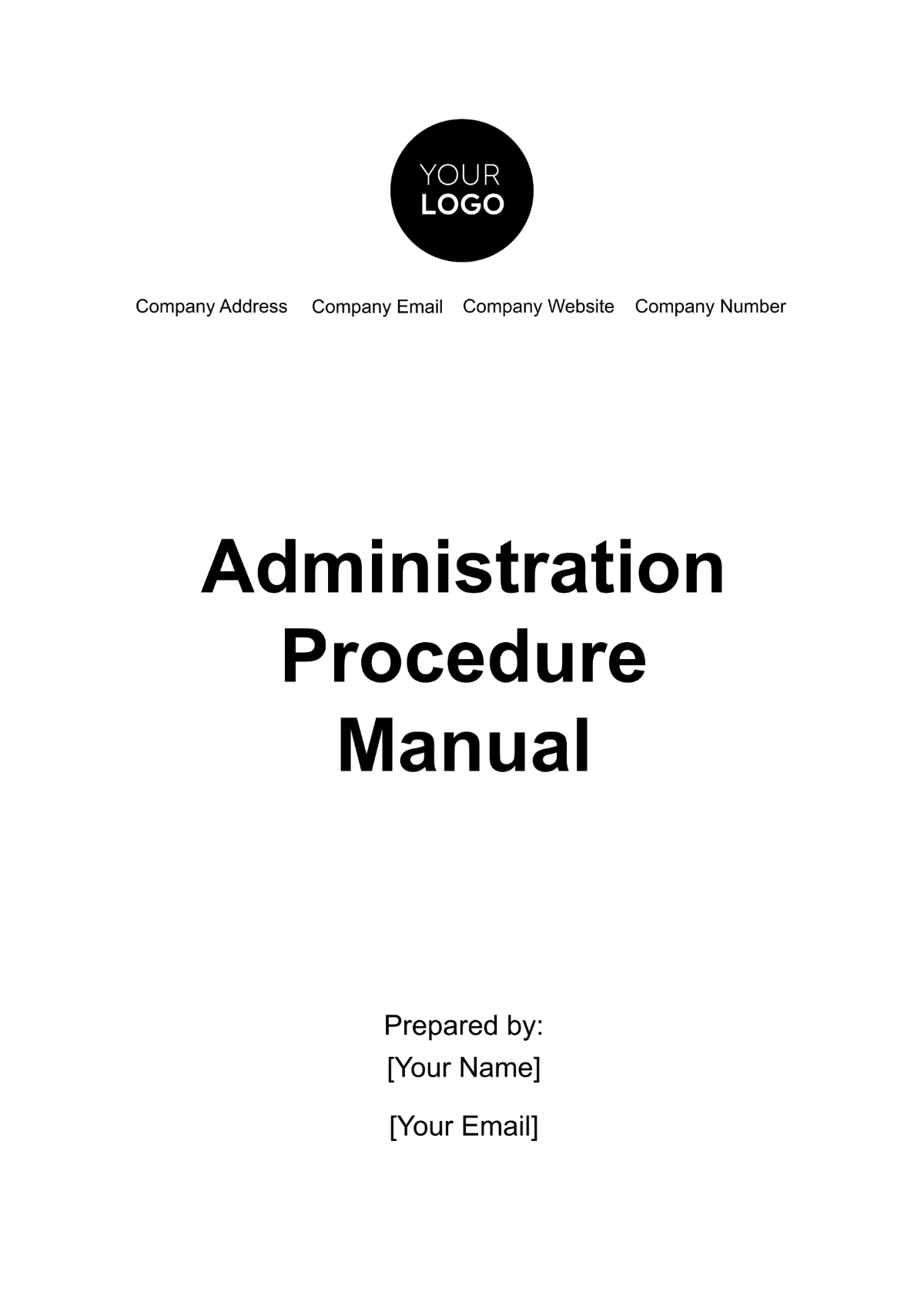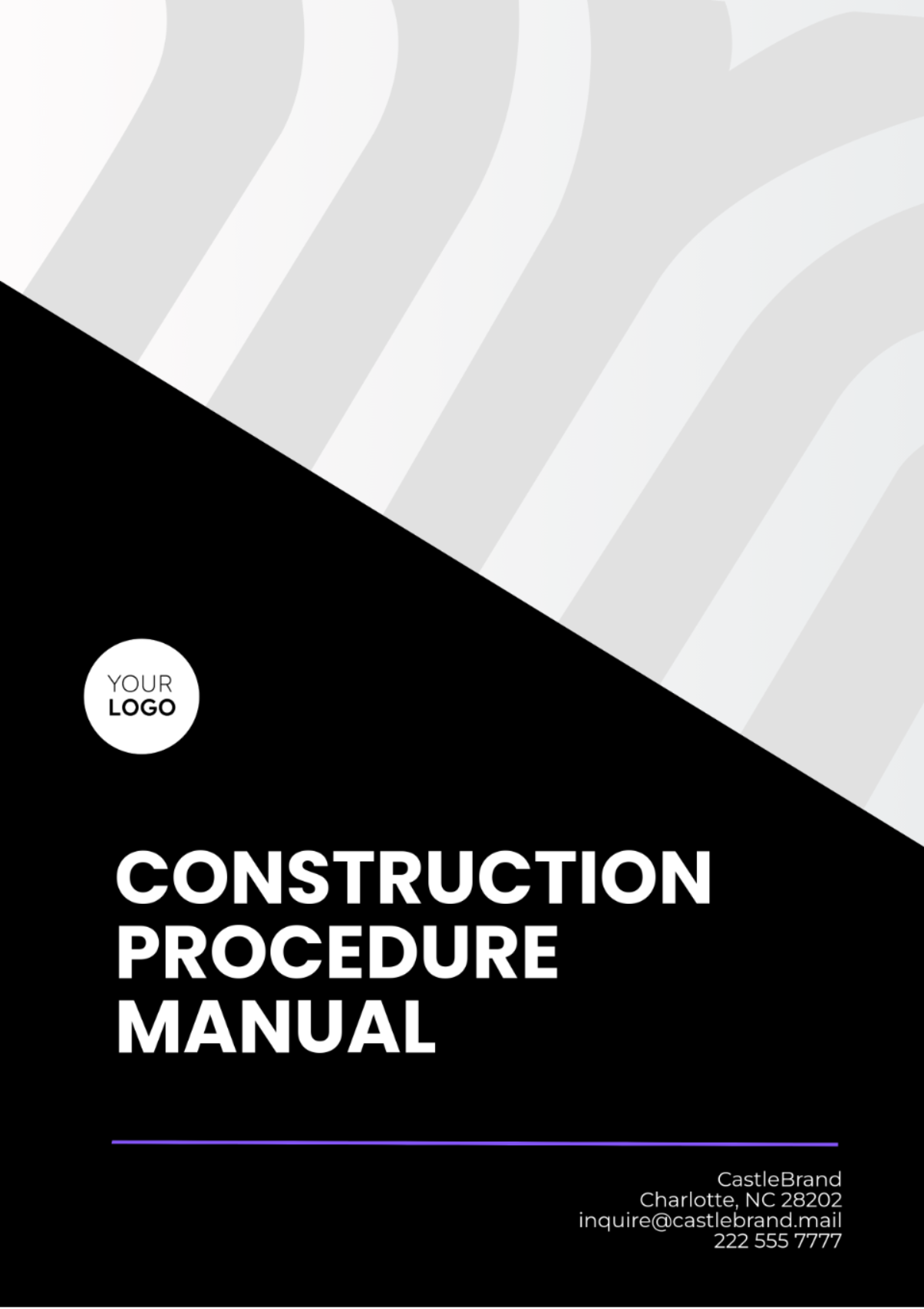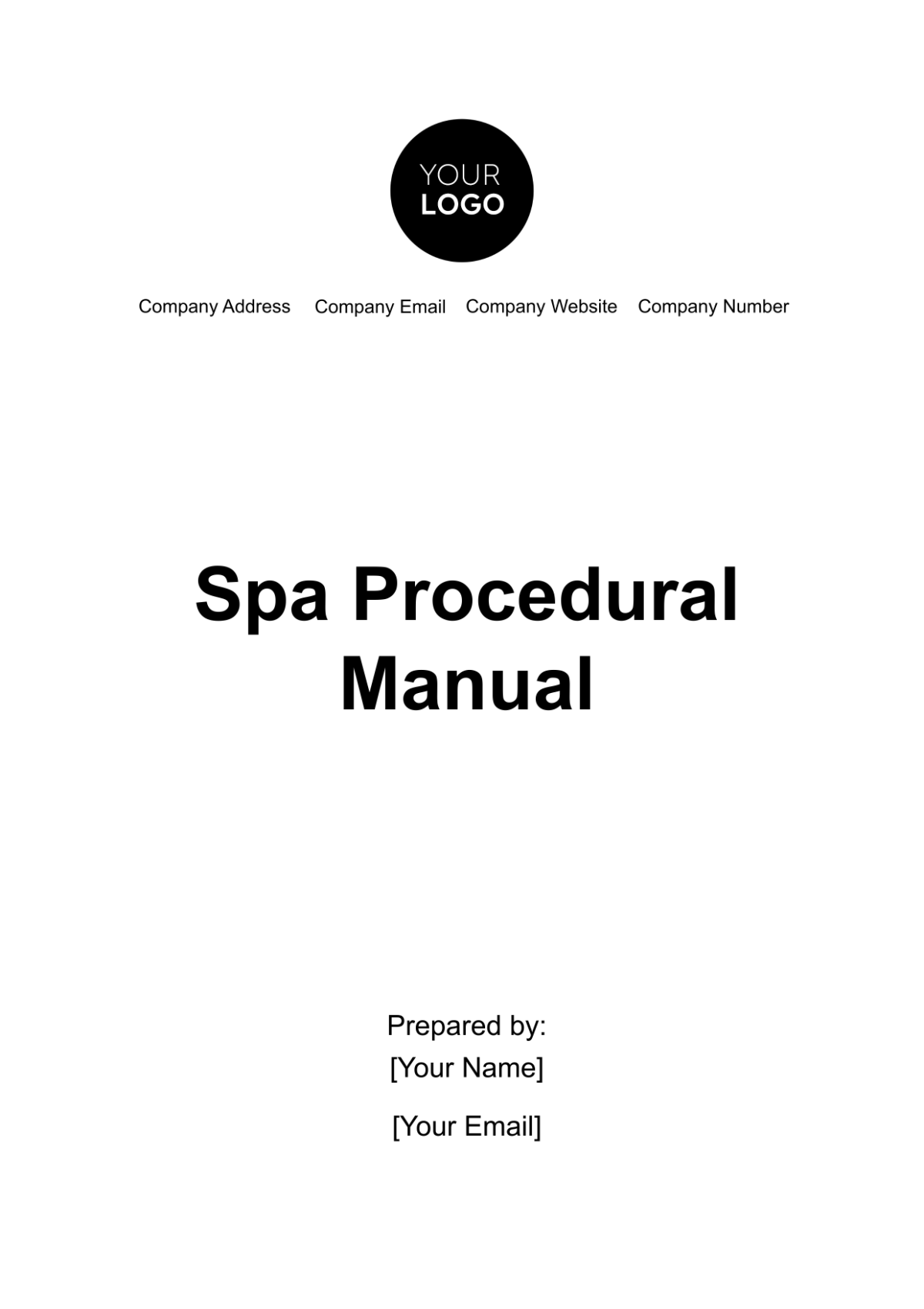I. Introduction
Welcome to the Administration Office Administration Policy & Procedure Manual of [Your Company Name]. This manual serves as a comprehensive guide for all employees, contractors, and visitors accessing our administration office facilities. By adhering to the policies and procedures outlined in this manual, we ensure consistency, efficiency, and compliance with organizational standards.
II. Purpose
The purpose of this manual is to establish clear guidelines for the administration of office operations. These guidelines encompass various aspects of office management, including office procedures, administrative support services, technology usage, health and safety protocols, compliance, training, and document control. The primary objectives of this manual are to:
Provide a framework for the efficient and effective operation of our administration office.
Ensure that all employees understand their roles and responsibilities within the office environment.
Promote a safe, secure, and professional work environment for all personnel.
Facilitate compliance with regulatory requirements and company policies.
Support the ongoing training and development of our workforce.
Establish procedures for the review, approval, and distribution of administrative documents.
Below is a table outlining the key objectives of the Administration Office Administration Policy & Procedure Manual:
Objective | Description |
|---|---|
Efficient Office Operation | Provide guidelines for streamlined office procedures and effective administrative processes. |
Clarity of Roles and Responsibilities | Define the roles and responsibilities of employees and management within the office setting. |
Safety and Professionalism | Promote a safe, secure, and professional work environment for all personnel. |
Regulatory Compliance | Ensure compliance with relevant laws, regulations, and company policies. |
Training and Development | Support the ongoing training and development of employees to enhance job performance. |
Document Control and Management | Establish procedures for the review, approval, and distribution of administrative documents. |
III. Scope
The Administration Office Administration Policy & Procedure Manual applies to all employees, contractors, and visitors who utilize the administration office facilities of [Your Company Name]. This manual encompasses all administrative activities and functions conducted within the office premises. The scope of this manual includes, but is not limited to, the following areas:
Office Procedures: Guidelines for office hours, attendance, dress code, communication, equipment, and security.
Administrative Support Services: Procedures for reception, mail handling, telephone usage, travel arrangements, and vendor management.
Technology Usage: Policies for computer usage, internet and email usage, data security, and IT support.
Health and Safety: Protocols for emergency procedures, ergonomics, health and wellness programs.
Compliance: Requirements for regulatory compliance, policy adherence, and reporting procedures.
Training and Development: Onboarding processes, continuous training opportunities, and professional development initiatives.
Document Control: Procedures for document approval, distribution, retention, and revision.
IV. Roles and Responsibilities
A. Management
Management plays a crucial role in overseeing the administration office and ensuring its smooth operation. Responsibilities include:
Defining and enforcing administration policies to maintain order and efficiency.
Providing necessary resources and support to facilitate office functioning.
Ensuring compliance with regulatory requirements and legal standards.
Monitoring and evaluating administrative processes to identify areas for improvement.
B. Administration Staff
Administration staff members are integral to the daily operations of the office. Their responsibilities include:
Adhering to established policies and procedures outlined in the manual.
Assisting in the implementation of office protocols and guidelines.
Reporting any deviations or issues to management for resolution.
Participating in training and development programs to enhance skills and knowledge.
V. Office Procedures
The Administration Office Administration Policy & Procedure Manual establishes standardized procedures to ensure efficient and effective office operations. These procedures cover various aspects of daily activities within the office environment.
A. Office Hours
Standard office hours are [8:00 AM - 5:00 PM], Monday to Friday.
Alternative schedules must be approved by management.
Employees are expected to adhere to their designated work hours.
Overtime may be required based on business needs.
B. Attendance and Punctuality
Prompt attendance is crucial for smooth office operations.
Employees must notify their supervisor of any absences or tardiness.
Excessive absenteeism or tardiness may result in disciplinary action.
C. Dress Code
Business casual attire is appropriate unless otherwise specified.
Employees should maintain a professional appearance.
Special events may require formal attire.
D. Communication Protocols
Use professional language and tone in all communications.
Respond to emails and calls promptly.
Maintain confidentiality when handling sensitive information.
E. Equipment and Supplies
Report any equipment malfunctions to IT support.
Use office supplies responsibly.
Requests for additional supplies must be approved by [Management].
F. Office Security
Keep office doors locked when not in use.
Do not share access codes or keys with unauthorized individuals.
Report any security concerns to [Security Officer].
G. Confidentiality
Safeguard confidential information at all times.
Use secure methods for transmitting sensitive data.
Unauthorized disclosure of confidential information is prohibited.
H. Records Management
Maintain accurate records and documentation.
Follow established protocols for filing and storage.
Dispose of records in accordance with retention policies.
I. Meetings
Schedule meetings in advance when possible.
Prepare agendas and distribute materials prior to meetings.
Document meeting minutes and action items.
VI. Administrative Support Services
Administrative support services play a vital role in facilitating smooth office operations and ensuring a positive experience for employees, clients, and visitors.
A. Reception Services
Greet visitors in a courteous manner.
Provide assistance and directions as needed.
Maintain a tidy and welcoming reception area.
B. Mail Handling
Sort and distribute incoming mail promptly.
Prepare outgoing mail for pickup or delivery.
Follow procedures for handling confidential mail.
C. Telephone Usage
Answer calls promptly and professionally.
Transfer calls to the appropriate party.
Use voicemail effectively for missed calls.
D. Travel Arrangements
Coordinate travel bookings for employees.
Ensure compliance with travel policies and budgets.
Provide necessary documentation and itinerary details.
E. Expense Reimbursement
Submit expense reports in a timely manner.
Include receipts and supporting documentation.
Expenses must adhere to company policies and guidelines.
F. Vendor Management
Evaluate vendor proposals and contracts.
Maintain vendor relationships and communication.
Ensure timely payment of invoices.
G. Facility Management
Monitor office facilities for cleanliness and maintenance.
Report any issues or repairs to the facilities manager.
Coordinate office layout and furniture arrangements.
VII. Technology Usage
Technology is integral to modern office operations, and it is essential to establish clear guidelines for its usage to ensure efficiency, security, and compliance with company policies.
A. Computer Usage Policy
Use company-provided computers for work-related tasks only.
Install software and updates only with IT approval to maintain system integrity.
Adhere to cybersecurity best practices, including regular password changes and avoiding the use of unauthorized software or applications.
B. Internet and Email Usage
Access the internet for business purposes only, refraining from visiting non-work-related websites.
Use company email for professional communication, refraining from sending or accessing inappropriate or offensive content.
Exercise caution when opening email attachments and links to prevent phishing attacks and malware infections.
C. Data Security
Protect sensitive data from unauthorized access by implementing strong password protection and encryption measures.
Avoid sharing sensitive information via unsecured channels and utilize secure file transfer protocols when necessary.
Follow data backup procedures regularly to ensure data integrity and availability in the event of system failures or data breaches.
D. Software and Hardware Procurement
Request software and hardware through designated channels to ensure compatibility with existing systems and adherence to licensing agreements.
Obtain approval before purchasing technology assets to prevent duplication of resources and ensure alignment with budgetary constraints.
Coordinate with IT support to install and configure new software and hardware components efficiently.
E. IT Support
Contact IT support for technical assistance and troubleshooting when encountering issues with hardware, software, or network connectivity.
Follow established procedures for reporting IT issues, providing detailed information to facilitate prompt resolution.
Adhere to IT security protocols and guidelines to minimize the risk of cybersecurity incidents and data breaches.
VIII. Health and Safety
Maintaining a safe and healthy work environment is paramount to the well-being of employees and visitors. The following policies and procedures are in place to promote health and safety within the administration office:
A. Emergency Procedures
Familiarize yourself with emergency exit routes and procedures to evacuate the building safely in the event of a fire, natural disaster, or other emergencies.
Follow instructions from designated emergency personnel and cooperate with emergency response teams to ensure everyone's safety.
Participate in emergency drills and training sessions to prepare for various emergency scenarios effectively.
B. Ergonomics
Maintain proper posture and ergonomic setup at your workstation to prevent musculoskeletal injuries and discomfort.
Adjust chair height, monitor position, and keyboard placement to optimize comfort and productivity.
Take regular breaks and perform stretching exercises to alleviate muscle tension and reduce the risk of repetitive strain injuries.
C. Health and Wellness Programs
Participate in company-sponsored health and wellness programs to promote physical and mental well-being.
Access resources for stress management, mental health support, and preventive care services.
Take advantage of flexible work arrangements and employee assistance programs to maintain a healthy work-life balance.
IX. Compliance
Ensuring compliance with relevant laws, regulations, and company policies is imperative for maintaining the integrity and reputation of the organization. The following policies and procedures are established to promote adherence to compliance standards:
A. Regulatory Compliance
Stay informed about and comply with all applicable laws, regulations, and industry standards relevant to the administration office's operations.
Regularly review and update policies and procedures to reflect changes in regulatory requirements and ensure ongoing compliance.
Cooperate with regulatory agencies and authorities during audits, inspections, and investigations to demonstrate compliance with legal and regulatory obligations.
B. Policy Compliance
Adhere to company policies and procedures outlined in the Administration Office Administration Policy & Procedure Manual.
Seek clarification or guidance from management or the compliance officer if there is uncertainty about any policy or procedure.
Report any violations or breaches of company policies or procedures to the appropriate authorities for investigation and resolution.
X. Training and Development
Investing in the training and development of employees is essential for enhancing skills, knowledge, and job performance. The following policies and procedures are in place to support training and development initiatives:
A. Onboarding
Complete mandatory onboarding training upon joining the company to familiarize oneself with company policies, procedures, and culture.
Participate in orientation sessions and training workshops to gain insight into job responsibilities, expectations, and performance standards.
Engage with mentors, supervisors, and colleagues to facilitate a smooth transition into the organization and foster professional development.
B. Continuous Training
Participate in ongoing training and development programs to enhance skills, knowledge, and competencies relevant to job roles and responsibilities.
Attend workshops, seminars, and conferences to stay updated on industry trends, best practices, and emerging technologies.
Pursue professional certifications and credentials to demonstrate expertise and proficiency in specific areas of expertise.
XI. Policy Review and Updates
Regular review and updates of policies and procedures are essential to ensure alignment with evolving business needs, regulatory requirements, and industry best practices. The following procedures are established for policy review and updates:
Annual Review: The Administration Office Administration Policy & Procedure Manual will undergo a comprehensive review by [Management] on an annual basis to assess its effectiveness, relevance, and compliance with regulatory requirements.
Revision Process: Proposed revisions to policies and procedures may be initiated by any employee or department within the organization. Suggestions for changes should be submitted to [Designated Contact] for review and consideration.
Approval: Proposed revisions will be reviewed by [Management] and subject matter experts to assess their impact and feasibility. Once approved, updated policies and procedures will be documented and communicated to all relevant stakeholders.
XII. Document Control
Effective document control procedures are essential for ensuring the accuracy, accessibility, and integrity of administrative documents. The following document control procedures are established:
Document Approval: All policies and procedures within the Administration Office Administration Policy & Procedure Manual must be approved by [Management] before implementation. Proposed documents will undergo review and approval by designated reviewers to ensure accuracy, clarity, and compliance with company standards.
Distribution: Once approved, updated policies and procedures will be distributed to all relevant employees via designated channels, such as email, intranet, or printed copies. Distribution lists will be maintained to ensure that all employees have access to the most current version of the manual.
Revision Control: A document revision log will be maintained to track changes made to policies and procedures over time. The revision log will include details such as the date of revision, reason for change, and approving authority. Previous versions of documents will be archived for reference purposes.
Training: All employees will receive training on new or revised policies and procedures to ensure understanding and compliance. Training sessions will be conducted by training coordinator and may include presentations, workshops, or online modules.

















































